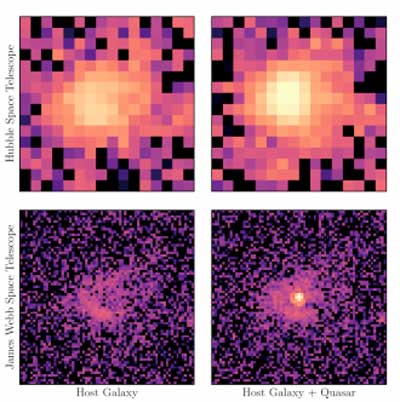| Oct 14, 2020 |
Blinded by the light no more: Simulations show James Webb Telescope will reveal hidden galaxies
|
|
(Nanowerk News) The telescope, due to launch in late 2021, is the largest, most powerful and complex space telescope ever built.
|
|
Two new studies (The Astrophysical Journal, "Limits to Rest-frame Ultraviolet Emission from Far-infrared-luminous z ∼ 6 Quasar Hosts" and Monthly Notices of the Royal Astronomical Society, "The host galaxies of z = 7 quasars: predictions from the BlueTides simulation") led by Madeline Marshall from Australia’s University of Melbourne and the ARC Centre of Excellence in All Sky Astrophysics in 3 Dimensions (ASTRO 3D) find that the Webb will be able to reveal galaxies currently masked by powerful lights called quasars.
|
 |
| Image of a galaxy and the flare from its quasar taken by the Hubble Space Telescope (top), and the same galaxy as it would appear when imaged by the James Webb Space Telescope. (Image: Marshall, et al)
|
|
Quasars are the brightest objects in the universe and among the most energetic. They outshine entire galaxies of billions of stars. In fact, their glare is so intense that astronomers compare it to looking directly into the headlights of an oncoming car and trying to figure out the make and model of the automobile.
|
|
“We want to know what kind of galaxies these quasars live in,” said Ms Marshall.
|
|
“That can help us answer questions like: How can black holes grow so big so fast? Is there a relationship between the mass of the galaxy and the mass of the black hole, like we see in the nearby universe?”
|
|
Observing these objects is very difficult with the capabilities of current telescopes. The more distant a galaxy is, the more its light has been stretched to longer wavelengths by the expansion of the universe. As a result, ultraviolet light from the black hole’s accretion disk or the galaxy’s young stars gets shifted to infrared wavelengths.
|
|
The James Webb Space Telescope is an infrared observatory, designed to see this light from the distant universe.
|
|
“Ultimately, Webb’s observations should provide new insights into these extreme systems,” said ASTRO 3D co-author Stuart Wyithe of the University of Melbourne.
|
|
“The data it gathers will help us understand how a black hole could grow to weigh a billion times as much as our Sun in just a billion years. These big black holes shouldn’t exist so early because there hasn’t been enough time for them to grow so massive.”
|
|
For their research, Ms Marshall and colleagues from Australia, the US, China, Germany, and The Netherlands used the near-infrared capabilities of NASA’s Hubble Space Telescope to study known quasars in hopes of spotting the surrounding glow of their host galaxies, without significant detections.
|
|
This suggests that dust within the galaxies is obscuring the light of their stars. Webb’s infrared detectors will be able to peer through the dust and uncover the hidden galaxies.
|
|
“Hubble simply doesn’t go far enough into the infrared to see the host galaxies. This is where Webb will really excel,” said Rogier Windhorst of Arizona State University in Tempe, a co-author on the Hubble study.
|
|
To determine what Webb is expected to see, the team used a state-of-the-art computer simulation called BlueTides, developed by a team led by ASTRO 3D distinguished visitor Tiziana Di Matteo from Carnegie Mellon University in Pittsburgh, Pennsylvania, US.
|
|
“BlueTides is designed to study the formation and evolution of galaxies and quasars in the first billion years of the universe's history. Its large cosmic volume and high spatial resolution enables us to study those rare quasar hosts on a statistical basis," said Yueying Ni of Carnegie Mellon University, who ran the BlueTides simulation. It provides good agreement with current observations and allows astronomers to predict what Webb should see.
|
|
The team found that the galaxies hosting quasars tended to be smaller than average, spanning only about 1/30 the diameter of the Milky Way despite containing almost as much mass as our galaxy.
|
|
“The host galaxies are surprisingly tiny compared to the average galaxy at that point in time,” said Marshall.
|
|
The galaxies in the simulation also tended to be forming stars rapidly, up to 600 times faster than the current star formation rate in the Milky Way.
|
|
“We found that these systems grow very fast,” explained Di Matteo. “They’re like precocious children – they do everything early on.”
|
|
The team then used these simulations to determine what Webb’s cameras would see if the observatory studied these distant systems. They found that distinguishing the host galaxy from the quasar would be possible, although still challenging due to the galaxy’s small size on the sky.
|
|
“Webb will open up the opportunity to observe these very distant host galaxies for the first time,” said Marshall.
|

